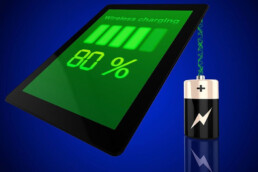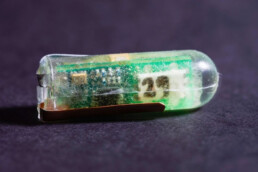Researchers devise efficient power converter for internet of things
Design reduces converter’s resting power consumption by 50 percent.
The “internet of things” is the idea that vehicles, appliances, civil structures, manufacturing equipment, and even livestock will soon have sensors that report information directly to networked servers, aiding with maintenance and the coordination of tasks.
Those sensors will have to operate at very low powers, in order to extend battery life for months or make do with energy harvested from the environment. But that means that they’ll need to draw a wide range of electrical currents. A sensor might, for instance, wake up every so often, take a measurement, and perform a small calculation to see whether that measurement crosses some threshold. Those operations require relatively little current, but occasionally, the sensor might need to transmit an alert to a distant radio receiver. That requires much larger currents.
Voice control everywhere
Low-power special-purpose chip could make speech recognition ubiquitous in electronics.
The butt of jokes as little as 10 years ago, automatic speech recognition is now on the verge of becoming people’s chief means of interacting with their principal computing devices.
In anticipation of the age of voice-controlled electronics, MIT researchers have built a low-power chip specialized for automatic speech recognition. Whereas a cellphone running speech-recognition software might require about 1 watt of power, the new chip requires between 0.2 and 10 milliwatts, depending on the number of words it has to recognize.
Secure wireless chargers
New chip would thwart the counterfeiting that plagues the market for wired device chargers.
Counterfeit chargers for portable electronics are a major problem. At the end of 2016, Apple claimed that of 100 Apple-branded charging accessories it bought on Amazon, 90 were counterfeits. Around the same time, Britain’s Chartered Trading Standards Institute reported that of 400 counterfeit chargers it bought from a range of online retailers, 397 failed a basic safety test.
In the last few years, portable electronics that can be recharged wirelessly have started coming to market. In an effort to get ahead of the problem of counterfeit wireless chargers — which could cause power surges that fry a device’s circuitry — researchers from MIT’s Microsystems Technology Laboratories have built a chip that blocks attempts to wirelessly charge a device’s battery unless the charger first provides cryptographic authentication.
Make it your business
StartMIT, a boot camp on entrepreneurship, gives students an intimate look into what it takes to build a company.
If you daydream about founding a startup, know this: CEOs are made, not born. Theodora Koullias ’13 — founder of the tech-fashion company Jon Luu — explained on Jan. 17 to a group of students and postdocs what it’s really like. “You learn on the job all the time.”
Koullias candidly shared her experience as part of StartMIT, a course packed with practical instruction and mentorship, designed to give aspiring entrepreneurs a boost up the founder learning curve. Held Jan. 9-23 during MIT’s Independent Activities Period, StartMIT gave participants a chance to form teams and develop their ideas into venture capital-worthy pitches. Students learn about the smorgasbord of ingredients that go into making a startup: creating a value proposition, staking a claim to intellectual property, working with the press, networking, creating culture, and, of course, raising money.
Engineers harness stomach acid to power tiny sensors
Ingestible electronic devices could monitor physiological conditions or deliver drugs.
Researchers at MIT and Brigham and Women’s Hospital have designed and demonstrated a small voltaic cell that is sustained by the acidic fluids in the stomach. The system can generate enough power to run small sensors or drug delivery devices that can reside in the gastrointestinal tract for extended periods of time.
This type of power could offer a safer and lower-cost alternative to the traditional batteries now used to power such devices, the researchers say.
“We need to come up with ways to power these ingestible systems for a long time,” says Giovanni Traverso, a research affiliate at the Koch Institute for Integrative Cancer Research. “We see the GI tract as providing a really unique opportunity to house new systems for drug delivery and sensing, and fundamental to these systems is how they are powered.”




